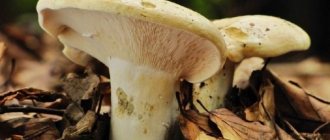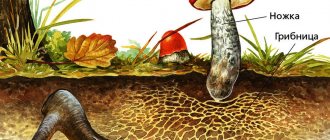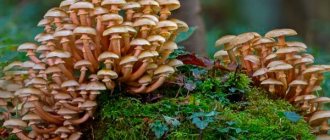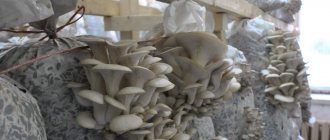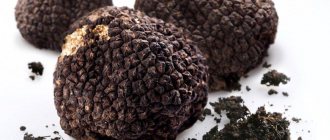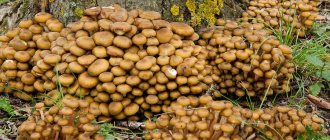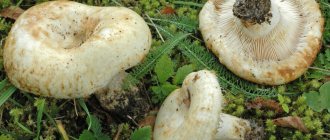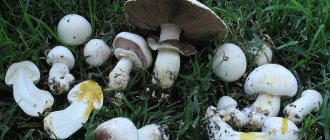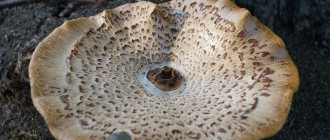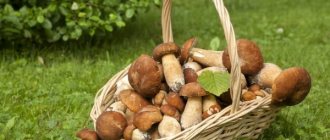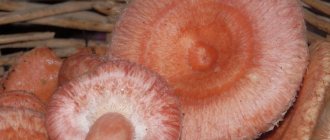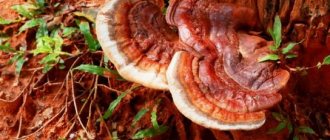Milk mushrooms are held in high esteem by mushroom pickers and are especially popular. Salted milk mushrooms in barrels are a favorite natural delicacy for mushroom lovers. The thick aroma of milk mushrooms is also appreciated when preparing hot mushroom dishes. The white dense flesh of the mushrooms has absorbed the smells of the forest, and milk mushrooms make other products fragrant when cooked together.
Delicious milk mushrooms quickly fill you up. The dense structure of the mushroom allows you to bring the harvested crop to the kitchen intact. Milk mushrooms rarely grow alone. With a successful mushroom hunt, they collect several baskets of first-class mushrooms.
In nature, milk mushrooms have chosen different forests, but they still prefer birch and pine-birch tracts. They hide under a layer of fallen pine needles and leaves. They find mushrooms by lifting up the withered forest floor.
Milk mushrooms: types, benefits
The breast is considered a real Russian mushroom. In Western, Eastern and Southern countries they don’t even know about them.
In our region, these mushrooms were able to firmly enter the consciousness of every person. They are considered the most wonderful forest gift, and therefore have won the hearts of our compatriots.
In many regions of Russia, for example, in Siberia, these mushrooms were one of the types of industrial mushrooms for a long period of time. Ideal nutritional properties combined with widespread fruiting are why they are in demand among people.
The main purpose of the mushroom is pickling. Other dishes must be prepared from salted preparations. But mushrooms are not suitable for frying, stewing and other similar cooking methods.
Milk milk contains so much protein that it can easily replace meat. The particular benefit of the mushroom is that it is used to create drugs that fight tuberculosis. After all, the components of the mushroom are able to neutralize the dangerous Koch bacillus. Next, we will consider in detail the types of mushrooms.
Interesting facts
Volnukha yellow.
- For a long time in Russia, especially in the Siberian regions, milk mushrooms were the only mushroom collected and therefore received the title “King of Mushrooms.”
- Historically, milk mushrooms were a staple dish in monasteries and among the clergy during Lent.
- Salted milk mushrooms are mentioned in many historical sources. For example, Martial, a Roman poet of the 1st century AD, wrote about milk mushrooms that it is easier to give silver than to bring milk mushrooms as a gift.
White and black milk mushrooms: benefits and harms
Many people claim that mushrooms are either edible or poisonous. However, there are also conditionally edible ones. This category includes black milk mushrooms.
Professional mushroom pickers, of course, know about this. But beginners don’t know this. This type of mushroom is called conditionally edible because it contains poison.
Milk mushrooms: harm and benefit
If you just fry black milk mushrooms in a frying pan, then this poison will not disappear anywhere. As a result, you can get severely poisoned or even die.
Such mushrooms must be washed thoroughly, and then cooked for 3 hours. Only in this way will all the poison disappear.
White milk mushroom brings both harm and benefit to the human body. It all depends on how well the mushroom is prepared.
Use
Due to the caustic milky juice, eating yellow milk mushrooms fresh is impossible. First, the mushroom undergoes a long soaking or, less commonly, boiling to get rid of bitterness. After which the mushroom is most often salted.
Occasionally, yellow milk mushroom is included in other dishes - salads and soups. It is valued by amateurs for its taste, which is practically not inferior to the white milk mushroom, its size (some specimens reach the size of a small plate) and for the fact that it is quite rarely affected by worms.
Where, in what forest do milk mushrooms grow?
There are situations when in one forest there will be a lot of mushrooms, in another there will be very few or only poisonous ones. Choosing the right forest is a huge success in finding them. If you decide to go for milk mushrooms, pay attention to our recommendations:
- The forest should be neither young nor old. After all, mushrooms have not yet appeared in a very young forest, and the old forest is very overgrown.
- Low grass should grow around each tree. As a rule, mushrooms are practically not found in tall grass.
Milk mushrooms in the forest
- Choose a forest that is very humid or try to go in the morning when dew has fallen.
- In a good area you can smell mushrooms. In the area where you want to find milk mushrooms, there is usually a mushroom smell and a moist aroma.
When to pick milk mushrooms?
If you decide to go in search of a milk mushroom, then you should consider the following: as a rule, this mushroom grows in lowlands, because they do not like dry soil. If sandy or dry soil predominates in the forest where you are going, then you don’t have to look for milk mushrooms there.
Collection of milk mushrooms
Now let's figure out exactly when it is necessary to collect these mushrooms. It all depends on their variety:
- Look for oak or aspen mushrooms at the end of July and until the end of September
- It is better to look for blue milk mushrooms closer to August and until the end of this month
- You can start collecting yellow and pepper milk mushrooms from mid-summer until the end of August
- If you want to find the black species, then head into the forest in July. They will grow there until September
Of course, the terms that we have offered you are considered only conditional. Remember that when you collect these mushrooms, make sure that the forest is sufficiently moist. Because milk mushrooms do not grow in dry soil.
In addition, take a closer look at the local vegetation. If you notice horsetail, then you will not find mushrooms in this area. This plant is considered the first sign that the soil in this forest is acidic. But milk mushrooms don’t like such soil.
Are there false milk mushrooms, poisonous, what do they look like, how to distinguish them from real ones?
Among the large assortment of edible types of mushrooms, milk mushrooms are given one of the first places. There is no mushroom picker who can bypass this mushroom, since it is distinguished by its rather bright and nutritious taste.
It’s a shame, but you can often find false squeaky mushrooms, which have a number of distinctive features. In addition, the papillary milk mushroom may end up in the basket. It can cause quite serious poisoning.
False breast
If you want to understand what exactly this mushroom looks like, you need to see a real one in person. You also need to get acquainted with the main distinguishing features and compare these features with the appearance of false mushrooms.
- The initial appearance of the cap of an edible mushroom is this: the cap is convex and has curled edges. Over time, the cap takes on a different shape. Its edges rise, creating a funnel shape in the central part.
- The cap of the edible mushroom is moist and quite dense. May have a white or cream color. As a rule, it is covered with twigs, dirt, and mucus.
- The plates of the edible mushroom are white, with yellow edges. The edges themselves are wide or quite loose. If you take a false mushroom, then it has dense, hard and thick plates that look unnatural. Often, it is thanks to the plates that one can distinguish a real milk mushroom from a poisonous one.
- Real milk mushrooms have a large amount of milky juice.
- The edible mushroom has only white flesh.
Milk mushroom is a mushroom that has a large number of false twins. But many of these mushrooms are considered conditionally edible, since according to certain characteristics they are similar to real ones.
Some common lookalikes
Milk mushrooms and other conditionally edible mushrooms of this family are not poisonous, but not very pleasant to the taste buds. People preparatory process the mushrooms, then cook them. The milk mushrooms are soaked and boiled for a long time with salt.
Pepper milk mushroom
The fruiting body of the mushroom is creamy-white; in mature specimens, the cap has the shape of a funnel with many gills. When pressed, it bleeds whitish milk with a peppery taste. Widely distributed in Europe, the Black Sea region in northeastern Turkey, eastern North America, and introduced to Australia. Forms a symbiotic relationship with deciduous trees, including beech and hazel, and grows in the soil from summer to early winter.
Mycologists consider it inedible and poisonous; culinary experts do not recommend it because of its taste. In its raw form, difficult to digest. In folk practice, it is used as a seasoning after drying, boiled, fried in butter, pickled, baked in dough.
The mushroom is prized in Russia. People harvest pepper milk mushrooms during the dry season, when other edible mushrooms are less available. In Finland, cooks boil mushrooms many times and drain the water. The latter is stored in chilled salted water all winter, pickled or served in salads.
Eating fresh and raw mushrooms irritates the lips and tongue; the reaction goes away within an hour.
Camphor milkweed (camphor milkweed)
They appreciate it for its smell. Cooks use it as a spice, not for cooking. The size of the camphor milkweed is small to medium, the cap is less than 5 cm in diameter. Color ranges from orange to orange-red and brown. The shape of the cap is convex in young specimens, flat and slightly depressed in mature mushrooms.
The fruiting body is fragile and brittle, secretes a whitish and watery-looking milk, similar to whey or skim milk. The juice has a mild or slightly sweet taste, but is not bitter or acrid. The smell of the mushroom has been compared to maple syrup, camphor, curry, fenugreek, and burnt sugar. The aroma is weak in fresh samples, becoming strong when the fruit body dries out.
Dried mushrooms are ground into powder or infused in hot milk. Some people use L. camphoratus to make a smoking mixture.
Violin (felt weight)
This is a fairly large mushroom found near beech trees. The fruiting body is dense, non-fibrous, and when damaged, the fungus releases colostrum. Mature specimens have caps from white to cream color, funnel-shaped, up to 25 cm in diameter. The wide stem is shorter than the fruiting body. The gills are distant from each other, narrow, with brown spots from dried juice. The spore print is white.
The mushroom is collected in deciduous forests from late summer to early winter. Milk juice has a neutral taste on its own, but is spicy if consumed with pulp. In the West, felt milk mushroom is considered inedible due to its pungent taste. In Russia, before cooking, they soak for a long time, then salt.
Golden-yellow milkweed (golden milkweed)
It is pale in color, poisonous, and grows in symbiosis with oak trees. The cap is 3–8 cm across, with dark markings of rough rings or stripes. At first it is convex, but later smoothes out; in older specimens there is a small central depression, the edges are without lint.
The whitish or pale yellow stalk is hollow, cylindrical or slightly swollen, sometimes pinkish on the lower half. The gills of the hymenophore are frequent, straight, with a pinkish tint, the spores are white-cream.
The whitish pulp has a pungent taste and is colored with abundantly secreted milk. Colostrum is initially white, but after a few seconds it turns bright sulfur yellow.
Golden milkweed appears in summer and autumn in the northern temperate zones of Europe, North America and North Africa.
Consumption results in predominantly acute, severe gastrointestinal symptoms.
What poisonous mushroom can be confused with milk mushroom?
The milkweed, which has a gray-pink color, is very similar to the white milk mushroom. It should not be eaten as it is considered deadly to the human body.
This mushroom has a cap up to 12 cm wide, dense, fleshy, convex or flattened in the form of a funnel. From the very beginning, the cap of the mushroom has bent edges, which eventually droop, dry out, and become covered with small scales. As the mushroom ages, its cap becomes bare, becomes red, pink or pink-brown, and after drying, blurry spots appear on the cap.
Milky
The leg of the milkweed is dense, up to 8 cm long and up to 4 cm wide. The shape is in the form of a cylinder. The flesh of the mushroom is yellow with a red tint. The bottom of the leg is colored reddish-brown. The milkweed grows from mid-summer to mid-autumn.
How to distinguish a black milk mushroom from a pig?
- The pig mushroom is considered to be a lamellar mushroom. It differs from the milk mushroom in that the size of its cap is 20 cm
- The young mushroom has a convex, and over time flat, funnel-shaped, velvety, yellow-brown cap
- The flesh of the mushroom has a light brown tint, which darkens after cutting.
- The plates of the mushroom in the lower part are connected by cross veins
- These veins can be separated from the cap without any problems
pigs
- Leg length is narrow, plain, approximately 9 cm
- It is located in the center or slightly to the side
- As a rule, the mushroom is found in a variety of forests, in the form of large groups
- Breeding period is from mid-summer to mid-October
A fat pig has a larger size. Its color is dark brown, and the stem of the mushroom is velvety. In the first and second types, a large number of harmful compounds accumulate, including heavy metals.
Beneficial features
Mushrooms have a diuretic effect and are indicated for urolithiasis, biliary tract dysfunction, and renal failure. They quickly satisfy the feeling of hunger, which is why nutritionists recommend including them in the diet of people losing weight. Value for the human body:
- regulate blood sugar levels;
- used as a basis for the manufacture of medicines against emphysema and tuberculosis;
- facilitate natural bowel movements;
- improve the functioning of the nervous system and the condition of the skin;
- boost immunity;
- strengthens hair.
Salted milk mushrooms exhibit anti-inflammatory and anti-sclerotic properties.
How to distinguish a white milk mushroom from a toadstool?
The white milk mushroom does not have a thickening in the form of a tuber, which is located at the bottom of the toadstool's stem. The toadstool itself is considered a rather dangerous mushroom. Basically, its appearance resembles that of russula.
Toadstool
The grebe has a green cap, in some cases almost white. There is a ring on the stem of the mushroom near the cap. If you do not want to confuse this mushroom with white milk mushroom, remember the following rule: mushrooms that are intended for pickling have a hole on the stem. This indicates that this or that mushroom is considered edible.
How to process milk mushrooms after harvesting?
You need to know that each mushroom tends to deteriorate quickly, therefore, they need to be washed and cleaned as quickly as possible.
- To begin, wipe the mushroom with a dry piece of cloth.
- Then remove dark places from it and clean the leg from dirt.
- If the mushroom is very dirty or wormy, then it must be placed in cool, salty water.
- After soaking the mushroom, you can cook it.
